Cloud:Hosted Exchange
From VTX Public Wiki
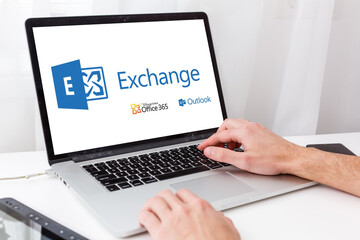
Hosted Exchange
Die professionelle, kollaborative, flexible und plattformübergreifende E-Mail-Lösung, personalisiert mit Ihren Domain-Namen. VTX Hosted Exchange ist eine zuverlässige und sichere E-Mail-Lösung, für die keine Investitionen in Hardware erforderlich sind. Mit der intuitiven Verwaltungsoberfläche (Control Panel) können Sie die Nutzer ganz einfach managen.
DNS-Einträge für Exchange
Damit Exchange richtig funktioniert, müssen die MX-Einträge Ihres Domainnamens geändert werden. Sie können auch einen CNAME-Eintrag für die automatische Konfiguration (autodiscover) sowie einen TXT-Eintrag erstellen, um die SPF von VTX zu benutzen.
Ist die DNS-Zone Ihrer Domain bei VTX gehostet, können wir die erforderlichen Änderungen durchführen. Andernfalls wenden Sie sich bitte an Ihren Informatiker, damit die Änderungen stattfinden können.
MX
- mx1.business-exchange.ch (Priorität 10)
- mx2.business-exchange.ch (Priorität 20)
CNAME
- autodiscover.[domain.tld] CNAME autodiscover-redirect.business-exchange.ch
Hinweis: Bitte ersetzen Sie "[domain.tld]" durch Ihren eigenen Domainnamen.
TXT (SPF)
- "v=spf1 a mx include:spf.vtx.ch ~all"
Hinweis: Die Anführungszeichen müssen im TXT-Eintrag enthalten sein.
Einloggen ins Control Panel
Sie können sich auf der Login-Seite für das Control Panel über folgenden Link anmelden: https://hex.vtx.ch/login/
Zur Anmeldung benutzen Sie bitte die Login-Daten, die Sie von VTX per E-Mail erhalten haben. Haben Sie sich eingeloggt, können Sie auf die Verwaltung Ihres Exchange-Diensts zugreifen.
Homepage Control Panel
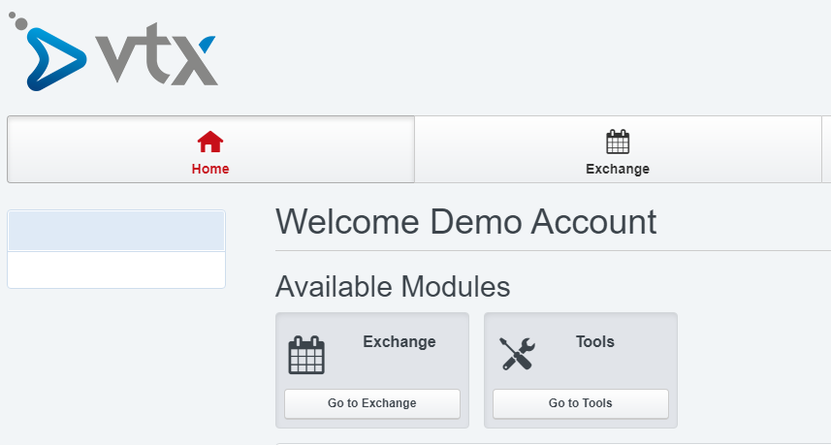
Passwort für das Control Panel ändern
Um das Passwort für Ihr Control Panel zu ändern, gehen Sie folgendermassen vor:
- Nachdem Sie sich angemeldet haben, klicken Sie auf das Menü Einstellungen.
- Geben Sie Ihr neues Passwort in das Feld Password ein. Bestätigen Sie es, indem Sie es erneut im Feld Passwort wiederholen erfassen.
- Klicken Sie auf Speichern.
Tipp: Sie können auch die Sprache für das Control Panel ändern. Hierzu wählen Sie die gewünschte Sprache in der Dropdown-Liste Sprache aus.
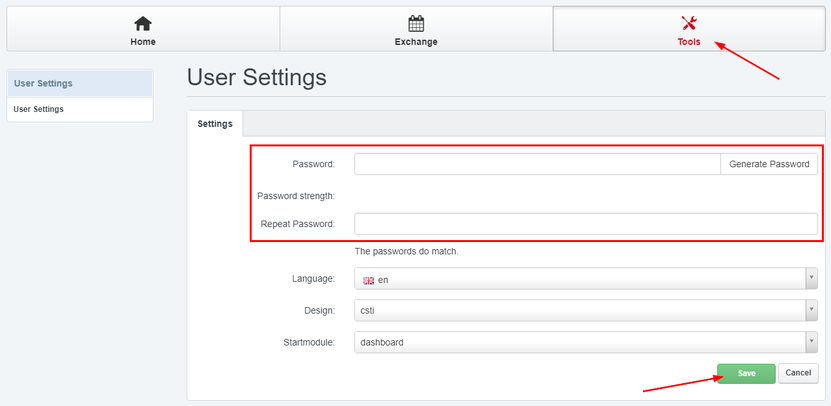
Einloggen über die Outlook Web App (OWA) von Exchange
Sie können sich in Ihren Posteingang (Postfach/ Inbox) mit Hilfe der Outlook Web App (OWA) von Exchange über den folgenden Link einloggen: http://mail.business-exchange.ch/
Hinweis: Es ist möglich, dass das Login sich vom Namen Ihrer E-Mail-Adresse unterscheidet. Um diesen Punkt abzuklären, können Sie sich in das Control Panel Ihres Exchange-Dienstes einloggen. Dann klicken Sie auf das Menü Exchange, dann auf Nutzerliste links. Auf der neuen Seite klicken Sie auf den Nutzer, der sich in OWA einloggen möchte. Dann gehen Sie auf den Reiter Exchange. Es gibt das Textfeld Address Email mit der E-Mail-Adresse des Exchange-Users. Darunter befindet sich das Textfeld Login Account, das im Allgemeinen der E-Mail-Adresse entspricht. Es kann jedoch auch etwas anderes sein. Gegebenenfalls ist es dieses Login, das man benutzen muss, um sich in OWA einzuloggen. Das Passwort ist dasjenige für die E-Mail-Adresse.
E-Mail-Konto auf Outlook 2019 einrichten
Dank der Funktion Autodiscover von Exchange könne Sie Ihr Konto ganz leicht auf Outlook konfigurieren. Das hier beschriebene Verfahren wurde mit Outlook 2019 durchgeführt. Doch es geht genauso für die früheren Versionen.
- From Outlook, go to the File tab and click on the + Add account button
- Then put the login of your email address (usually the same as the email address in question, if needed this can be checked from the control panel) in the text field and then click on the button Connect.
Note:' It is possible that the login differs from the name of your email address, to check this point, you can connect to the control panel of your Exchange service, then click on the Exchange menu then on Users List on the left. On the new page, click on the user who wishes to configure his mail account on Outlook and then go to the tab Exchange. A text field Address Email is present, indicating the email address of the Exchange user then underneath is the text field Login Account, this generally corresponds to the email address but can be different,if necessary it is this login that should be used to connect the mail account on Outlook, the password is that of the mail address.
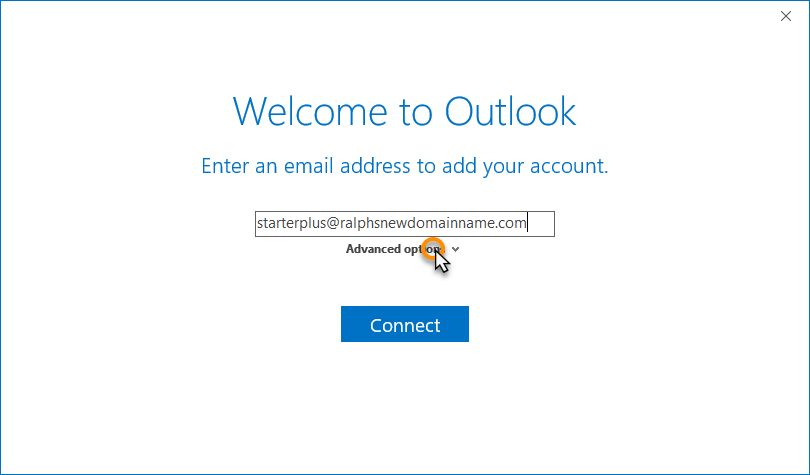
- Outlook will then start the configuration. After a few seconds, the password of your Exchange account will be asked, enter it, check the box Remember my credentials then click on the button OK
- Outlook will then confirm that the account has been added and configured, a restart of the account is necessary to finalize the configuration
Your account should now be set up and ready to use, click OK to close the wizard. Outlook 2019 is now configured to send and receive email through your mailbox.
Change the password of an Exchange account
It is possible to change the password of an Exchange mail account from the control panel, once connected to it:
- Click on the Exchange button and then on Users List on the left menu
- Click on the name of the Exchange user whose password you wish to change
- Go to the Password tab
Here you have the option to change the password without changing the current one. The new password must respect the complexity standards of the Microsoft Active Directory. Once the new password is entered, click on the Save button to save the changes.
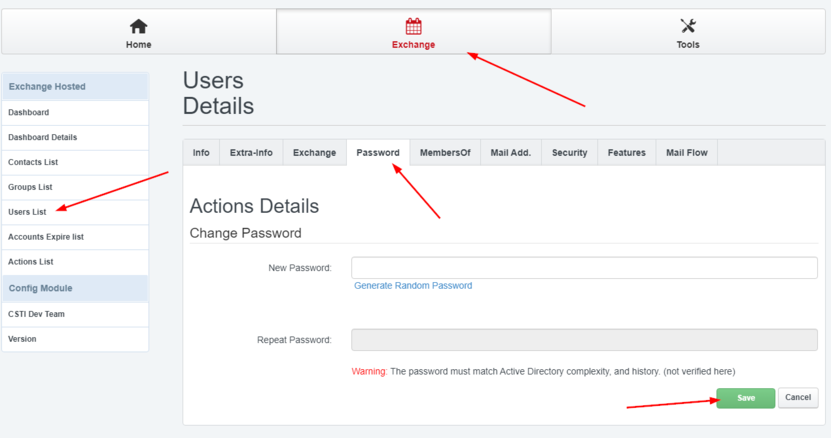
Controlling the quotas of an Exchange account
By default, each Exchange mail account has 25GB of storage space. Storage usage can be monitored on the control panel of your Exchange service.
Once you are logged into your control panel, click on the Exchange menu and then on Users List.
Click on the user whose storage space you wish to control and then click on the Exchange tab
There are 4 text fields that indicate usage:
- Exchange Limit (warning): Indicates the amount of storage space that the Exchange server informs you about the fill rate. Values in MB (megabytes)
- Exchange Quota Limit (sending): Indicates up to which amount of storage space used you can continue to send e-mails. Value in MB
- Exchange Quota Limit (sending and receiving): Specifies the quota of your e-mail address, if this limit is reached you will not be able to send/receive e-mails. Value in MB (megabytes)
- Mailbox Space Usage: Indicates the storage space currently used on your e-mail address, indicated in kB (kB). In MB, e.g. 1024kB = ~100MB. Value in MB (megabytes)
Adding an alias to an email address
From the Exchange service control panel it is possible to create an alias for an email address, so any emails sent to this alias will be delivered to the original Exchange user's inbox.
To create an alias, login to the control panel and then:
- Click on the Exchange button and then on Users List on the left menu
- Select the user you wish to add an alias for by clicking on the user's name
- Then go to the Mail Add. tab
- Put the alias in the text field New Email Address. Once this is done, click on the Save button
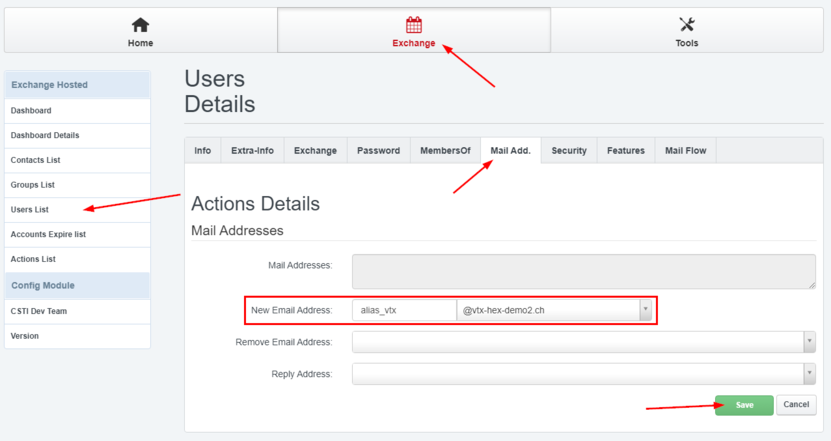
If you then go back to the user settings and click on the Mail Add. tab, you will see in the Mail Addresses text field the alias as well as the email address that should be used to reply to emails (reply address).
Add a forwardTo or copyTo to an email address
You can add a forwardTo or a copyTo to an Exchange user from the control panel. Once connected on this one:
- Click on the Exchange button then on Users List on the left menu
- Then click on the Mail Flow tab
- If you wish to set up a forwardTo, do not check the box Deliver both mailboxes, if you wish to activate a copyTo, check it.
- Change forward to: Select here the Exchange user to whom you want to forward / send a copy of the emails
- Active: Check the box Active (uncheck for remove transfer of emails) to activate the rule.
- Once the settings are entered, click on the Save button
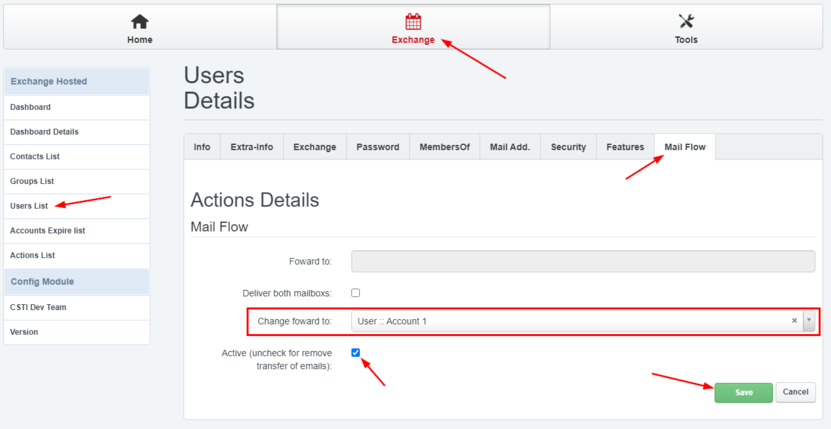
Related Products

|

|

|
| Veeam Backup for IaaS | Managed Cloud Server | Web Cloud Server |
| The enterprise cloud backup solution by VTX | Your critical applications on ahigh-availability virtual server | Host your websites on a virtual server optimised for the Web! |
